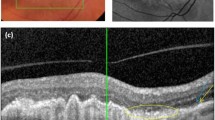Abstract
AMD is the main cause of visual impairment in people over 50 years of age and the most common cause of blindness. In recent years, the use of bevacizumab to treat neovascular AMD has become a preferred treatment in the United States. However, whether bevacozumab is available for RPE or AMD patients is unknown. We firstly indicate that Pam3CSK4 (P3C) activates TLR2 pathway during ARPE-19 apoptosis as determined by western blotting. And then, the expression of MyD88, NF-κB, p-IKK in primary RPE cells from AMD patients is significantly down-regulated after treatment with 50 µg L−1 Bevacizumab. Therefore, our data shows that MyD88 is involved in the TLR2 pathway in ARPE-19 cell apoptosis resulting from Pam3CSK4 (P3C). And more importantly, our findings suggested that Bevacizumab cured age-related macular degeneration (AMD) via down-regulate Toll—like receptor 2 (TLR2) pathway in RPE from AMD patients.
Similar content being viewed by others
Abbreviations
- AMD:
-
Age-related macular degeneration
- RPE:
-
Retinal pigment epithelium
- TLR2:
-
The mammalian toll like receptor 2
- P3C:
-
Pam3CSK4
References
Martin D.F., Maguire M.G., Ying G.S., Grunwald J.E., Fine S.L., Jaffe G.J., Ranibizumab and Bevacizumab for Neovascular Age-Related Macular Degeneration, N. Engl. J. Med., 2011, 364, 1897–1908
Jager R.D., Mieler W.F., Miller J.W., Age-related macular degeneration, N. Engl. J. Med., 2008, 358, 2606–2617
Cipriani V., Matharu B.K., Khan J.C., Shahid H., Stanton C.M., Hayward C., et al., Genetic variation in complement regulators and susceptibility to agerelated. macular degeneration, Immunobiology, 2012, 217, 158–161
Hurwitz H., Fehrenbacher L., Novotny W., Cartwright T., Hainsworth J., Heim W., et al., Bevacizumab plus irinotecan, fluorouracil, and leucovorin for metastatic colorectal cancer, N. Engl. J. Med., 2004, 350, 2335–2342
Meyer C.H., Holz F.G., Preclinical aspects of anti-VEGF agents for the treatment of wet AMD: ranibizumab and bevacizumab, Eye (Lond), 2011, 25, 661–672
Luo Y., Zhuo Y., Fukuhara M., Rizzolo L.J., Effects of culture conditions on heterogeneity and the apical junctional complex of the ARPE-19 cell line, Invest. Ophthalmal. Vis. Sci., 2006, 47, 3644–3655
Hageman G.S., Mullins R.F., Molecular composition of drusen as related to substructural phenotype, Mol. Vis., 1999, 3, 25–28
Algvere P.V., Seregard S., Drusen maculopathy: a risk factor for AMD. Can we prevent visual loss?, Acta Ophthalmol. Scand., 2003, 81, 427–429
Bok D., New insights and new approaches toward the study of age-related macular degeneration, Proc. Natl. Acad. Sci. U.S.A., 2002, 99, 14619–14621
An E., Lu X., Flippin J., Devaney J.M., Halligan B., Hoffman E.P., et al., Secreted Proteome Profiling in Human RPE Cell Cultures Derived from Donors with Age Related Macular Degeneration and Age Matched Healthy Donors, J. Proteome. Res., 2006, 5, 2599–2610
Uh A., Simmons C.F., Bresee C., Khoury N., Gombart A.F., Nicholson R.C., et al., MyD88 and TRIF mediate the cyclic adenosine monophosphate (cAMP) induced corticotropin releasing hormone (CRH) expression in JEG3 choriocarcinoma cell line, Reprod. Biol. Endocrinol., 2009, 7, 74
Zhang F.X., Kirschning C.J., Mancinelli R., Xu X.P., Jin Y., Faure E., et al., Bacterial lipopolysaccharide activates nuclear factor-kappaB through interleukin-1 signaling mediators in cultured human dermal endothelial cells and mononuclear phagocytes, J. Biol. Chem., 1999, 274, 7611–7619
Bird A.C., Bressler N.M., Bressler S.B., An international classification and grading system for age-related maculopathy and age-related macular degeneration. The International ARM Epidemiological Study Group., Surv. Ophthalmol., 1995, 39, 367–374
Beatty S., Koh H., Phil M., Henson D., Boulton M., The role of oxidative stress in the pathogenesis of age-related macular degeneration, Surv. Ophthalmol., 2000, 45, 115–134
Uh A., Nicholson R.C., Gonzalez G.V., Simmons C.F., Gombart A., Smith R., et al., Lipopolysaccharide stimulation of trophoblasts induces corticotropinreleasing hormone expression through MyD88, Am. J. Obstet. Gynecol., 2008, 199, 317.e1–6.
Uh A., Simmons C.F., Bresee C., Khoury N., Gombart A.F., Nicholson R.C., et al., MyD88 and TRIF mediate the cyclic adenosine monophosphate (cAMP) induced corticotropin releasing hormone(CRH) expression in JEG3 choriocarcinoma cell line, Reprod. Biol. Endocrinol., 2009, 7, 74
Kumar M.V., Nagineni C.N., Chin M.S., Hooks J.J., Detrick B., Innate immunity in the retina: Toll-like receptor (TLR) signaling in human retinal pigment epithelial cells, J. Neuroimmunol., 2004, 153, 7–15
Yu F.S., Hazlett L.D., Toll-like Receptors and the Eye, Invest. Ophthalmol. Vis. Sci., 2006, 47, 1255–1263
Martin P.M., Ananth S., Cresci G., Roon P., Smith S., Ganapathy V., Expression and localization of GPR109A (PUMA-G/HM74A) mRNA and protein in mammalian retinal pigment epithelium, Mol. Vis., 2009, 15, 362–372
Miller K., Wang M., Gralow J., Paclitaxel plus bevacizumab versus paclitaxel alone for metastatic breast cancer, N. Engl. J. Med., 2007, 357, 2666–2676
Brechner R.J., Rosenfeld P.J., Babish J.D., Caplan S., Pharmacotherapy for neovascular age-related macular degeneration: an analysis of the 100% 2008 Medicare feefor- service Part B claims file, Am. J. Ophthalmol., 2011, 151, 887–895
Kook D., Wolf A., Kreutzer T., Neubauer A., Strauss R., Ulbig M., et al., Long-term effect of intravitreal bevacizumab(Avastin) in patients with chronic diffuse diabetic macular edema, Retina, 2008, 28, 1053–1060
Waintraub S.E., Tuchman V., The role of maintenance bevacizumab in patients with metastatic breast cancer treated with chemotherapy and bevacizumab upon achieving complete response or maximal radiologic response with stable disease, J. Clin. Oncol., 2008, 26(20 suppl), 120–122
Author information
Authors and Affiliations
Corresponding author
Additional information
These authors contributed equally to this work.
About this article
Cite this article
Wang, Z.L., di Qiao, B., Li, G.X. et al. Bevacizumab cured age-related macular degeneration (AMD) via down-regulate TLR2 pathway. cent.eur.j.biol. 9, 469–475 (2014). https://doi.org/10.2478/s11535-014-0290-5
Received:
Accepted:
Published:
Issue Date:
DOI: https://doi.org/10.2478/s11535-014-0290-5




